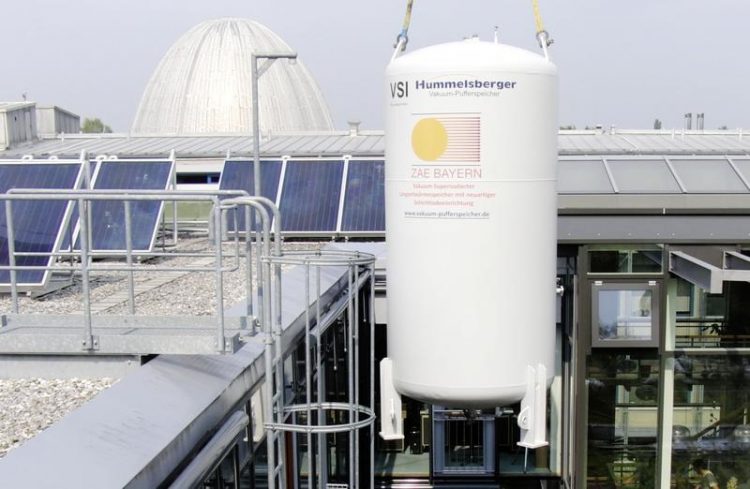Storing thermal energy with vacuum and volcanic rock technology

Full-size prototype: The vacuum super-insulated storage tank has a volumetric capacity of 6.5 cubic metres. © ZAE Bayern
To increase the proportion of heat supply covered by solar thermal energy, greater efficiency is called for in storage tank technology. The BINE Projektinfo brochure “Vacuum tank stores heat” (14/2014) details the development of a storage tank with an enclosure that exhibits very low thermal conductivity. A vacuum between the inner and outer tank and a perlite powder filling in the cavity facilitate favourable insulating values.
The vacuum super-insulated hot water storage tank can store thermal energy over several weeks or months. The technology allows high solar shares of fraction in existing small and medium-sized buildings compliant with the low-energy house standard. The long-term heat storage tank is already used in several single-family homes and apartment buildings.
Minimising heat transfer between the inner and outer tanks produced from steel was the objective of the research project. To do so, the researchers created a vacuum in the annular cavity using simple pump technology. This made it possible to effectively inhibit air heat transfer. Thermal radiation, however, still occurs in vacuums. To reduce this effect, the researchers poured the poorly thermally conducting volcanic rock perlite into the cavity.
The vacuum super insulated hot water storage tank has been developed by Bayerisches Zentrum für Angewandte Energieforschung (ZAE Bayern) in cooperation with steel and metal engineering company Hummelsberger from Upper Bavaria.
For further informations about the BINE-Projektinfo brochure “Vacuum tank stores heat” (14/2014) follow this link:
Press contact
Uwe Milles
presse(at)bine.info
About BINE Information Service
Energy research for practical applications
The BINE Information Service reports on energy research topics, such as new materials, systems and components, as well as innovative concepts and methods. The knowledge gained is incorporated into the implementation of new technologies in practice, because first-rate information provides a basis for pioneering decisions, whether in the planning of energy-optimised buildings, increasing the efficiency of industrial processes, or integrating renewable energy sources into existing systems.
About FIZ Karlsruhe
FIZ Karlsruhe – Leibniz Institute for Information Infrastructure is a not-for-profit organization with the public mission to make sci-tech information from all over the world publicly available and to provide related services in order to support the national and international transfer of knowledge and the promotion of innovation.
Our business areas:
• STN International – the world’s leading online service for research and patent information in science and technology
• KnowEsis – innovative eScience solutions to support the process of research in all its stages, and throughout all scientific disciplines
• Databases and Information Services – Databases and science portals in mathematics, computer science, crystallography, chemistry, and energy technology
FIZ Karlsruhe is a member of the Leibniz Association (WGL) which consists of 87 German research and infrastructure institutions.
Weitere Informationen:
http://www.bine.info/en – BINE Informationsdienst english
Media Contact
Alle Nachrichten aus der Kategorie: Energie und Elektrotechnik
Dieser Fachbereich umfasst die Erzeugung, Übertragung und Umformung von Energie, die Effizienz von Energieerzeugung, Energieumwandlung, Energietransport und letztlich die Energienutzung.
Der innovations-report bietet Ihnen hierzu interessante Berichte und Artikel, unter anderem zu den Teilbereichen: Windenergie, Brennstoffzellen, Sonnenenergie, Erdwärme, Erdöl, Gas, Atomtechnik, Alternative Energie, Energieeinsparung, Fusionstechnologie, Wasserstofftechnik und Supraleittechnik.
Neueste Beiträge

Nanofasern befreien Wasser von gefährlichen Farbstoffen
Farbstoffe, wie sie zum Beispiel in der Textilindustrie verwendet werden, sind ein großes Umweltproblem. An der TU Wien entwickelte man nun effiziente Filter dafür – mit Hilfe von Zellulose-Abfällen. Abfall…

Entscheidender Durchbruch für die Batterieproduktion
Energie speichern und nutzen mit innovativen Schwefelkathoden. HU-Forschungsteam entwickelt Grundlagen für nachhaltige Batterietechnologie. Elektromobilität und portable elektronische Geräte wie Laptop und Handy sind ohne die Verwendung von Lithium-Ionen-Batterien undenkbar. Das…

Wenn Immunzellen den Körper bewegungsunfähig machen
Weltweit erste Therapie der systemischen Sklerose mit einer onkologischen Immuntherapie am LMU Klinikum München. Es ist ein durchaus spektakulärer Fall: Nach einem mehrwöchigen Behandlungszyklus mit einem immuntherapeutischen Krebsmedikament hat ein…





















